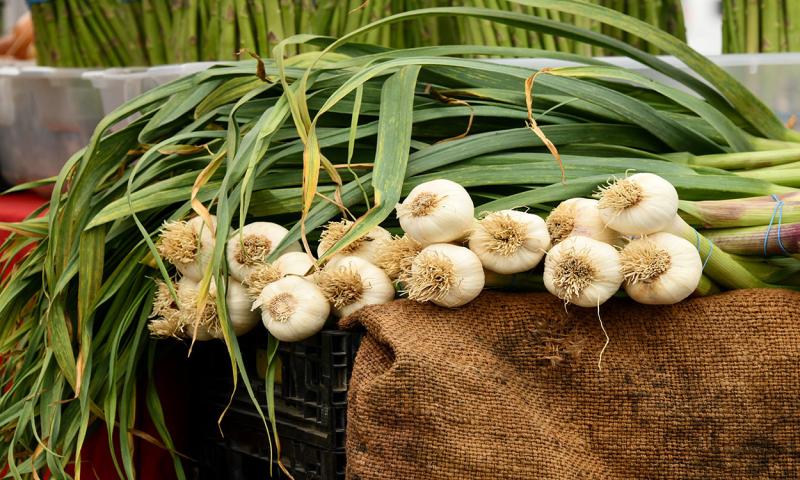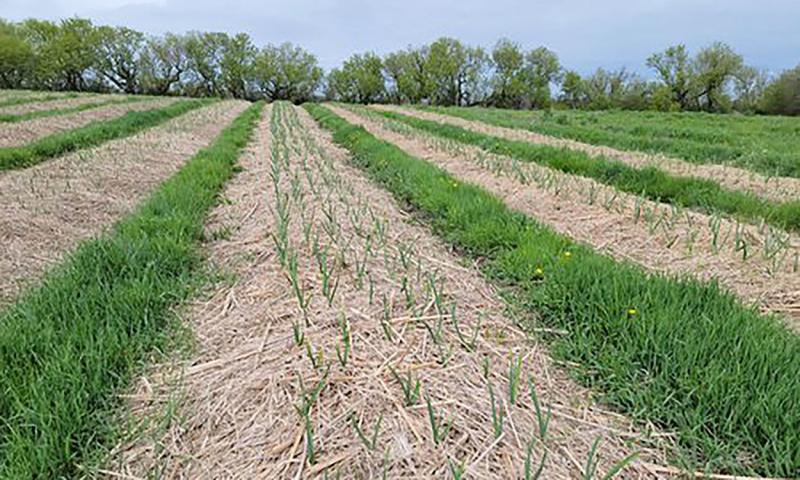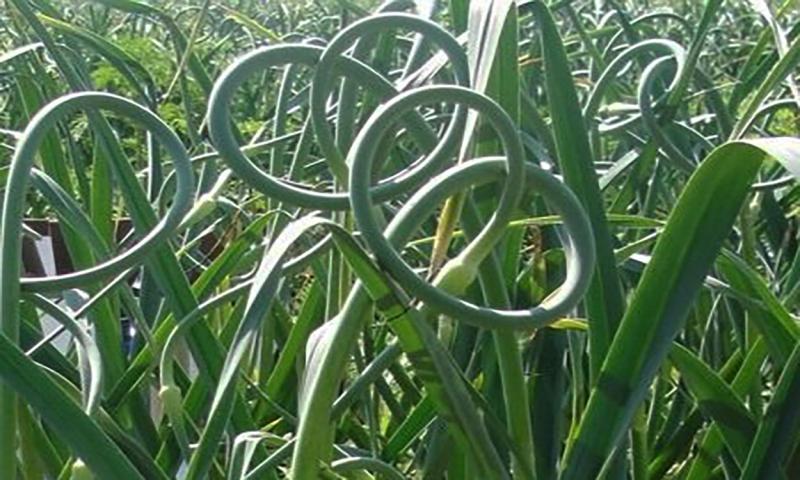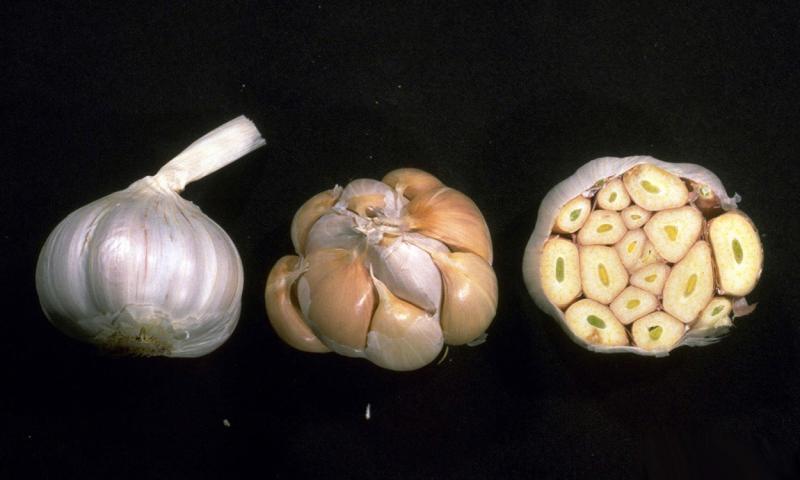Written by Rhoda Burrows, former Professor & SDSU Extension Horticulture Specialist.
Description

General Description: Garlic has been cultivated for thousands of years, for both its culinary and medicinal qualities. Garlic has antibacterial and antifungal properties, and studies have shown benefits for treatment of diabetes, cancer, heart disease, asthma and more.
Garlic is generally planted in the fall in South Dakota so that it undergoes chilling, which prepares it to grow and form bulbs under the long, warm days the following summer.
Types of Garlic
Most commercial garlic comes from California. These varieties will form only small bulbs under South Dakota conditions—if they survive our cold winters. However, there are plenty of options for us, as more than 100 varieties of garlic are grown in our neighboring state, Minnesota. South-Dakota-grown seed garlic is also available and adapted to our soil and climate.
-
Hardneck Garlic: The center stem in these garlics is very hard and often needs strong pruners to trim back at harvest, giving them their name. They grow best in colder climates with a cool, damp spring. They produce a flowering stalk, called a scape. Each head will produce four to five large, easy-to-peel cloves. Hardneck varieties tend not to store well (only a few months), although some, including Porcelain and Purple Stripe may last up to six months under good storage conditions. The flavor differs by variety, but it is generally stronger than softneck garlics. Some varieties have a great deal of heat and are excellent for roasting, which moderates the heat and adds a nutty flavor. Hardneck varieties are further divided into types, including: Porcelain, Rocambole, Purple stripe, Asiatic and Turban. Russian Giant, German Red, Spanish Roja, Penn Wonder, Merrifield Rocambole and Bogatyr are some hardneck varieties that are grown in our region.
-
“Softneck” Garlic: The center stem is soft and dries to a papery consistency. Softneck varieties store for six to eight months, and they are the kind used for garlic braids. They are good for long-term storage and have a milder flavor. They have up to 15 to 18 cloves per head and can be difficult to peel. They tend to produce more cloves then hardneck types, and they tend not to produce flowering stalks. Artichoke and Silverskin are two softneck types; Inchellium Red, Transylvanian and New York White are a few of the common softneck varieties grown in our region.
Planting

Site Selection and Preparation: Garlic should be planted in a sunny spot (at least 8 hours of sun daily), and ideally in rich, well-drained soil. Cultivate the soil at least eight inches deep, working compost into the soil (unless the soil already had heavy compost additions earlier in the season). Garlic does not compete well with weeds, so avoid weedy areas for planting. Do not plant where onions or garlic were planted within the past four years.
Planting: Garlic is grown from cloves, not seed. The individual cloves should be separated from the bulb no more than a day or two before planting. Larger cloves generally produce larger bulbs. Dipping the cloves in rubbing alcohol for a minute or two at planting will kill potential bacteria or fungal pathogens carried on the surface. Plant pointed side up, with the base of the clove about three inches deep. They may be planted in double rows, at least six inches apart in all directions. Covering the beds with three to six inches of loose mulch can both help protect the bed during winter and control weeds in the spring.

Timeline: Garlic is most often planted in the fall, one to three weeks after the first killing frost (Figure 3). The soil temperatures should be about 50 degrees Fahrenheit. While it is most reliable to plant garlic in the fall, if planted in the spring, it should be planted early, so that it undergoes about a month of cool temperatures (around 40 degrees Fahrenheit). If this is not successful, it will not form proper cloves.
Plant Care
Frost: Garlic shoots can tolerate air temperatures down to 20 degrees Fahrenheit without damage; temperatures below 10 degrees Fahrenheit may result in dieback and poor bulb development, so keep mulch on until temperatures are reliably warmer.
Watering: Garlic needs about an inch of water per week; more during hot, dry windy periods and less during the cooler spring. Amending the soil with compost or manure will help it retain moisture between rains or irrigation cycles. Once bulbs begin to mature, they do not need further watering, and may have a tendency to rot if the soil is too wet, or water accumulates at the base of the leaves. Ideally, watering should stop about 2 or so weeks prior to harvest to preserve the skins and create better harvest conditions.
Weeding: Garlic does not compete well with weeds, as the leaves will not shade out competitors. Weeds can also increase moisture around the plant, increasing the risk of fungal or bacterial disease. Early summer weed control (hand weeding and/or hoeing) is essential!
Fertilizer: Garlic requires a steady supply of nutrients, in part because it does not have extensive root systems. For best results, test the soil for nitrogen, phosphorous and potassium (NPK) prior to planting, and adjust the following recommendations accordingly. Most (but not all) existing soils in South Dakota will have enough potassium, but they will likely need nitrogen and possibly phosphorous.
Blood meal or feather meal are good nitrogen sources, and are relatively slow-release, so they can be applied at planting and again in the early spring, at a rate of about 2 cups per 100 feet. A lawn fertilizer (without herbicide) can be used if only nitrogen is required: for a typical formula of 34-0-0, apply about 2/3 cup per 100 feet of row, or a tablespoon per 10 feet of row. Incorporate about one-third of the required nitrogen at planting, and the rest in the spring. About one-half the remaining nitrogen should be applied in the spring as the plants just begin to grow, and the rest a few weeks later. Avoid applying nitrogen after scapes begin to form, as this may delay bulb formation. Another option is liquid fish fertilizer, applied every 7 to 14 days when the garlic is actively growing. Fish fertilizer formulations vary somewhat, but the supply phosphorous as well as nitrogen.

Garlic Scapes: In June, some hardneck varieties form scapes (Figure 4), which can decrease bulb formation if soils are poorly fertilized. Pull, snap or cut scapes just after they start curling. Do not discard them – they are prized for their mild garlic flavor and can be used in many recipes, as well as in floral arrangements. You may also want to leave a few, as they can help indicate proper harvest time (they will point straight up when it is time to harvest).
Pest and Diseases
General Pest Management: Garlic grown in South Dakota generally has few pest problems. It is very important to start with clean “seed” bulbs purchased from a reputable source. Proper crop rotation (that is, not planting garlic, onions, chives, or leeks in the same place two years in a row) will minimize many potential problems. Avoid areas that were recently planted to small grain crops (such as wheat or oats), as these may harbor mites that can damage the bulbs. If any disease problems appear, don’t plant onions or related plants in that spot for four years.
Harvest

Harvest: Stop watering garlic two weeks before harvest. Harvest when the lower leaves have died, and about half the upper leaves have turned brown. If in doubt, pull a bulb or two and cut them in half. The cloves should fill the skins. Harvesting too early can result in bulbs that store poorly. Harvesting too late can allow the bulbs to begin splitting open, reducing storage life and allowing molds to invade. They can be dug up with a garden fork.
An easy way to cure the harvested bulbs is to bundle up to ten together with stalks on and hang in a dry area out of the sun (such as a garage, porch or garden shed) for several weeks. The stalks will help draw moisture out from the bulb as they dry. Air movement is important to prevent mold on the skins. After this curing, you can cut the shoots one-half to one inch above the bulbs and remove the roots. The shoots may also be left on for hanging, if preferred; they may store longer in this form. If disease is not present, the largest cloves may be kept for planting that fall.
Storage and Preparation
Storage: Store garlic at room temperature. It may also be stored in the refrigerator. Do not refrigerate bulbs that you intend to plant in the fall. Remember that despite its appearance, garlic can bruise easily.
Average Yield: Ten feet of single-row garlic plants should yield about two pounds of garlic.
Nutrition Facts: One clove of garlic has under 5 calories and no fat.
Cooking: For information on preparing garlic, including recipes, fact sheets and tips for preserving garlic in your home kitchen, see our Pick it! Try it! Like it! resource for garlic.
This article was reviewed by Kristianna Gehant Siddens, Prairie Coteau Farm garlic producer.


